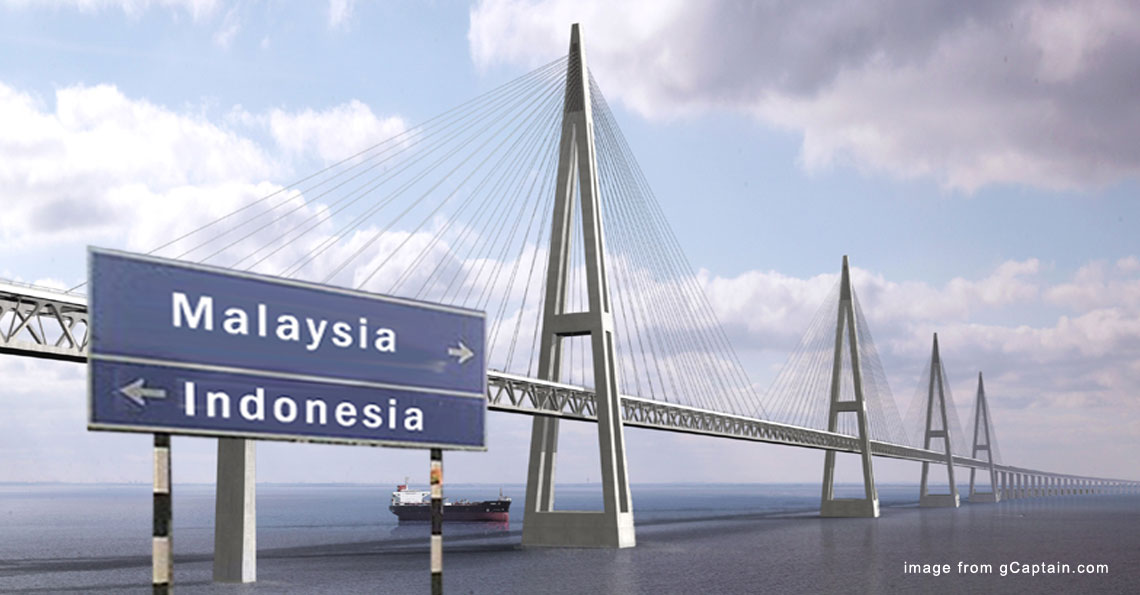This Malay man might have been the first to sail around the world

- 8.5KShares
- Facebook8.3K
- Twitter10
- LinkedIn20
- Email24
- WhatsApp123
PS: If you’d like more stories like this, please subscribe to our HARI INI DALAM SEJARAH Facebook group 🙂
While reading the history of Melaka for our article about the friendliest colonialists we’ve ever had, we came across something arguably even cooler.
When the Portuguese attacked Melaka, one man in the army was Ferdinand Magellan. If that name sounds familiar, it’s because Magellan was known for leading the first voyage around the world even though he died before completing it (spoiler, sorry), with another dude named Elcano being the first to actually do it. But more interestingly for us, we found that a Malay man from Melaka who followed them, possibly beat them as the first person to circumnavigate the globe.
This idea isn’t new, it was first brought up by Austrian philosopher Stefan Zweig back in 1938. There’s also a Malay novel loosely based on it. If you visit the Melaka Maritime Museum, there’s also a statue of him there.

In fact, there’s a whole Wikipedia entry on the guy, known as Enrique of Melaka, and how he might have beat Magellan and Elcano to successfully circumnavigating the world… without intending to, or even knowing that he did it. So grab some bubble tea, relax and get ready for an amazing story about cannibals, giants, friendship, red-wedding-like betrayals and just a tinge of speculation (don’t worry, we’ll be using primary sources!!!).
Leg #1: Melaka to Europe (via the Mollucas and Africa) – How Magellan and Enrique became BFFs
So let’s start with a map. On the bottom right you’ll see Melaka, where Enrique met Magellan, and we’ll try to show you via these blue world maps how he might have beaten the Spanish to the finish line.
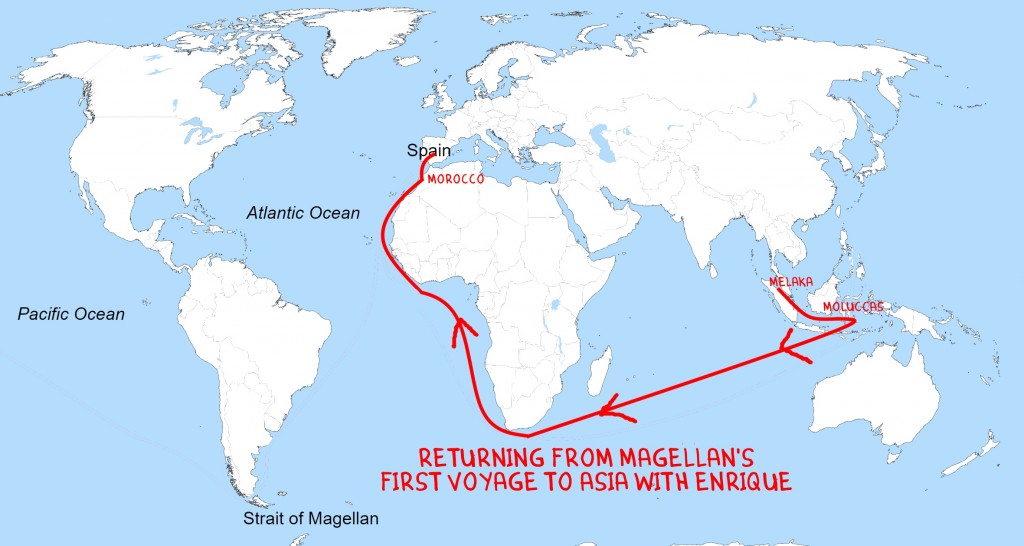
Not much is known about Enrique (not even his original name) before he met Magellan. Magellan, then a soldier in the Portuguese navy, was quite the progressive. He was sick of Afonso de Albuquerque’s harsh treatment of slaves (yeah, Albuquerque was every bit as mean as he was described as in your Sejarah books). So according to a Straits Times article on 22.10.1955, when he was offered a slave in the form of Enrique, Magellan immediately released him from his chains and asked him if the slave would serve him of his free will.
“Amazed at such a strange approach, the Malay fell at Magellan’s feet and kissed them, swearing he would be faithful unto death and never did he break that oath.” – Straits Times, 1955.
Magellan’s last will corroborates that the slave was then baptized as a Christian, and to symbolize this, he adopted the name Enrique. (A.K.A Enrique de Malaca in Spanish, Henrique de Malaca in Portuguese, Panglima Awang/Daeng Awang/Panglima Hitam in Malay and Henry in English. He’s also sometimes referred to as Enrique the Black).

Enrique followed Magellan everywhere he went, starting with a few Portuguese exploration missions, sailing possibly as far as the Moluccas (NOT Melaka k, it’s a very important source of Nutmeg and other spices). Portugal soon found itself in a war with Morocco, so they were recalled to Africa. Enrique proved a quick study of languages, quickly mastering Portuguese and Spanish in addition to his native Malay. Along the way, the pair became inseparable.
In Morocco, Magellan got injured in a battle and would walk the rest of his life with a limp. Magellan also developed a reputation of treating the Muslims kindly and trading with them, which got him exiled by the Portuguese king, forcing him to move to Spain with Enrique in tow (known then as Castille) after the war.
At the time, Portugal and Spain were like friendly rivals. To prevent arguments between Portugal and Spain, the Pope ‘divided’ the conquerable world in two. Portugal could claim everything to the East, and Spain gets everything to the West.
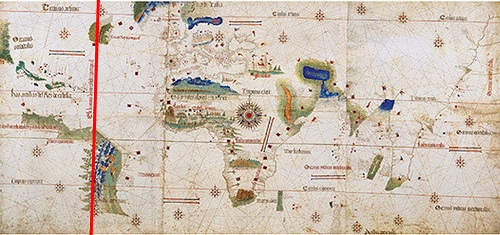
In Spain, Magellan had a epiphany. It was already pretty accepted at the time (maybe even more than now -_-) that the world was round. So Spain could get a piece of Asia, just by going the long way around – by circumnavigating the world!
Magellan presented this idea to the king of Spain, who was still kinda meh on the idea. Then Enrique walked in and spoke to the king in fluent Spanish and Malay. The king, suitably impressed, immediately agreed, granting 5 ships and a crew of 270 for the expedition.
Leg #2: Europe to America and the vast Pacific ocean – Cannibals, giants, straits and starvation
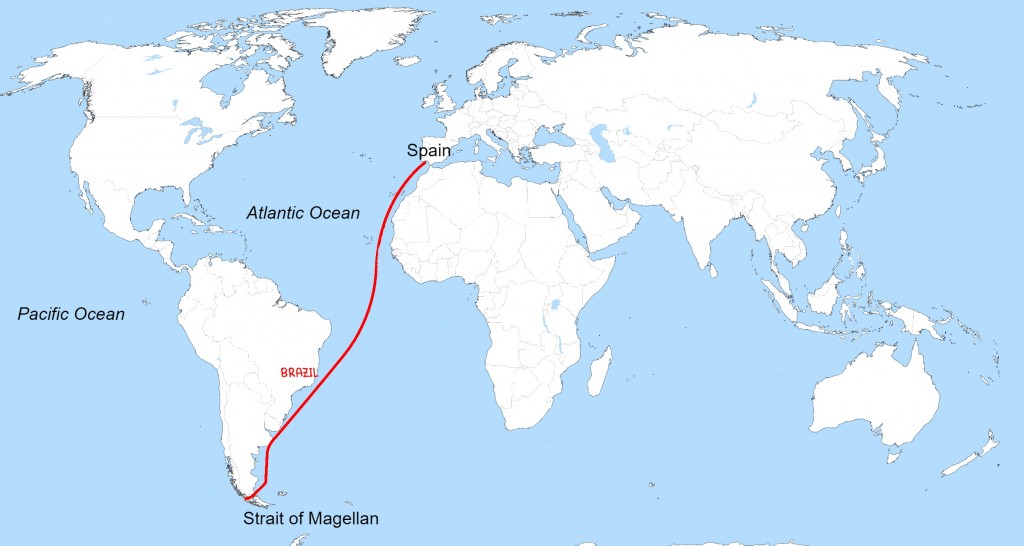
In the final days of the Spanish summer of 1519, Magellan with Enrique on board left for what would eventually be commonly recognised as the first trip of humans around the world. Also along for the ride was an Italian scholar named Pigafetta (yea we know, as if this story wasn’t haram enough), whose book is the primary evidence of Magellan’s quest.
Within 30 days, they arrived in South America where some friendly natives built them a house. After politely declining, they continued their journey and came across some cannibals who ended up eating a Spanish captain. They tried to chase the cannibals with a hundred men, but the cannibals ran very quickly. A few days later, they came across a naked singing giant, and met tribeswomen with er… “breasts as long as half an arm”. Magellan allegedly kidnapped two of the giants to ‘show and tell’ back in Spain, but sadly, they didn’t survive the journey.


Leg #3: Back to the good ol’ Southeast of Asia – Tragedy and betrayal

Despite being a surprisingly peaceful ocean, the Pacific was also surprisingly big. Over 3 months of open sea without any land to resupply caused the giants and many of the crew to die of malnutrition. However, on March 16th 1521, Magellan’s crew finally spotted something other than ocean – some big sampans. They had reached what’s known today as the Philippines.
This was Enrique’s time to shine. While the islanders had issues understanding him, he was able to converse with their chief (Malay was the lingua franca of trade, even here in the Philippines), and they exchanged gifts. With Enrique as his interpreter, Magellan soon gained the chief’s trust.

So close in fact, that he converted the chief to Christianity and decided (#orgputehniar) to make this chief the King of Sibu (modern day Cebu in the Philippines, not Sarawak k) to get an ally in the region.
However, a nearby chief refused to submit to the new Sibuan king. In typical European confidence, Magellan went with Enrique and 60 men to ‘convince’ the chief. Because the Spanish had guns, they told the newly anointed King of Sibu not to interfere and to watch from his boat. Unfortunately, the opposing chief had an army of thousands.

Magellan was killed, and the Spanish forces were defeated, fleeing back to the protection of Sibu. To this day, Filipinos consider Lapu-Lapu a national hero for defeating Magellan, even naming a city after him.

Enrique survived the battle, but spent the rest of the day wrapped up in a blanket. Pigafetta says it’s because of his wounds, but it’s possible he was also grieving over the death of his friend. In Magellan’s will, he wanted Enrique to be freed upon his death, even including a payment of 10 thousand coins. Enrique is the only slave ever mentioned in Magellan’s will. If that’s not friendship we don’t know what is.

Unfortunately, the guy that took over the Spanish quest was Duarte Barbosa, and he still needed an interpreter. He ignored Magellan’s will, even threatening to whip Enrique. Enrique, outraged, secretly arranged with the Sibuan king to kill the Spaniards and take their guns. The king agreed, and they planned a banquet, inviting the Spaniards to join him for dinner and “gifts”. And once the Spaniards were all comfy, they got murdered while they were eating.

There was a small crew, however, that didn’t attend the party – and they heard the screams, with one Spanish sailor literally crying bloody murder running back to the ships.
“Juan Serrano, in his shirt, wounded and bound, who entreated us, as loudly as he could, not to fire any more, or else he would have been massacred… And he said that all had been slain except the interpreter.” – Pigafetta [104]
The remaining Spanish crew didn’t even wait for the poor guy to reach the ship. They set sail immediately, and after realizing they were short on men, set one of the ships on fire and sailed the remaining two quickly back to Spain. One ship got attacked by the Portuguese before sinking in a storm (remember, the Portuguese technically ‘owned’ the seas in the area and were pissed to find the Spanish there).
The last ship, with Pigafetta and Elcano (the last surviving captain) aboard, managed to limp its way back to Spain (after 1.5 years of leaving the Philippines) in September, 1522 with a crew total of 18, out of the original 270, becoming widely known as the first men to sail around the world, making a small profit from the spices aboard.
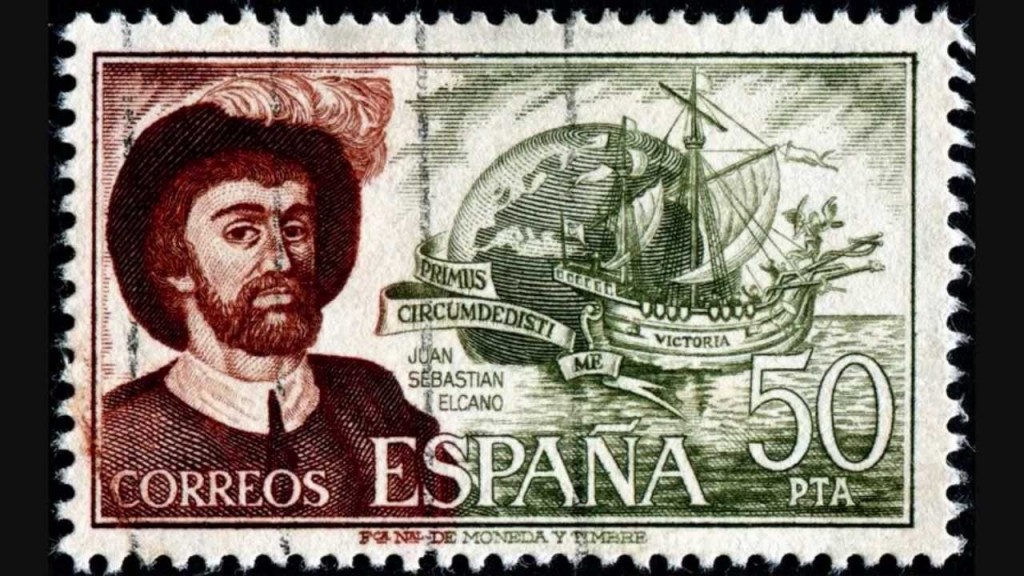
Wow. Not really your typical happy ending, and also… this was where Pigafetta’s accounts of Enrique end.
Leg 4: Back to Malaysia? – The theories of where Enrique ended up…
With Pigafetta’s accounts ending, here’s where the speculation starts. Maybe Enrique went home after this as Melaka was just a short boat ride away. Maybe he even hitched a ride from a trader.
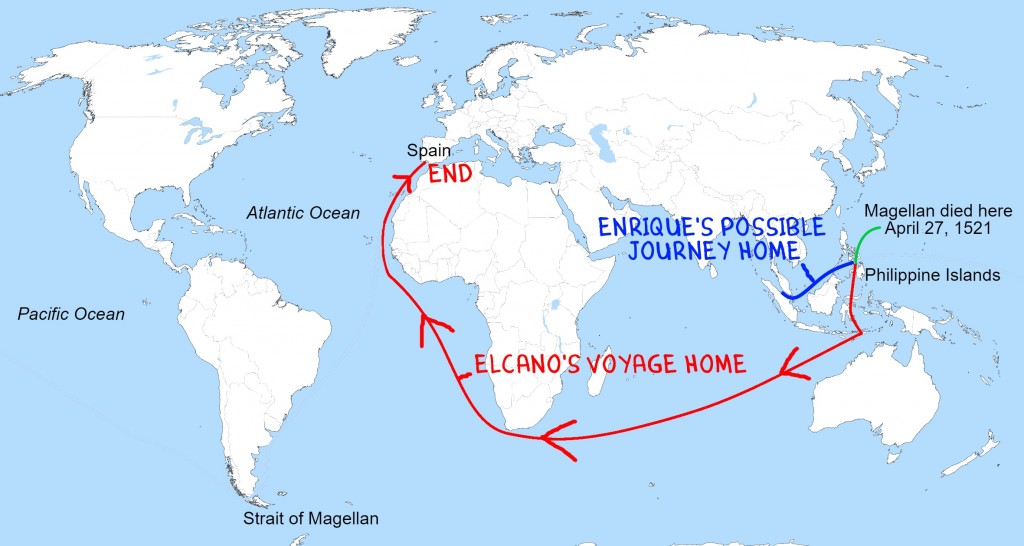
Wait wait, hold up. So if Enrique started in Melaka, then as long as he made it back to Melaka in 1.5 years, he would have beaten Elcano to be the first person to circumnavigate the world!
Mind you, when it comes to the first continuous ship voyage around the world, there’s no dispute that Elcano was the first. However, we’re talking about the first person to circumnavigate the world here.
Actually, this theory is quite possible: a few months ago, a team of researchers from Universiti Putra Malaysia located a grave in Rembau that just might belong to Enrique. According to the folklore, one of the traders from Melaka/Rembau was travelling to Sibu when he came across a young man who spoke Malay. The man followed him back to Rembau where he became a local figure well known for speaking multiple languages. He also changed his name to Sakai Laut Dalam to avoid getting found out by the Portuguese, and was very good at handling ships. Research on the date of the graves is still ongoing, so it’ll be very exciting to watch how this theory unfolds.

Another theory popular in the Philippines is that Enrique wasn’t even from Melaka, but was actually from Sibu (again, Philippines, not Sarawak). If true, that means that he would have finished his circumnavigation as soon as he reached the Philippines (but he wouldn’t be Bumiputera la, unless you consider him a Putera for going around the Bumi). Thing is, we know from Pigafetta’s account that Enrique actually struggled to speak with the Sibuans. But after meeting their chief, he was able to communicate and debate with him, likely in Malay which the educated chiefs probably understood. Whatever the case, there’s actually a Filipino movie about it which looks uh… okay la. Also, there’s some claims that he’s from Sumatra and that he traveled to work in Melaka, which is possible but not mentioned in any source to our knowledge. So, as far as we can tell, Magellan and Pigafetta call him Enrique of Melaka, and Melaka is in Malaysia… #doneclaim

But what if there was another way, one no one else seems to have brought up (we think… If this was mentioned elsewhere please let us know k)? Remember in Leg 1, when we mentioned that the Portuguese explored the Moluccas from Melaka?
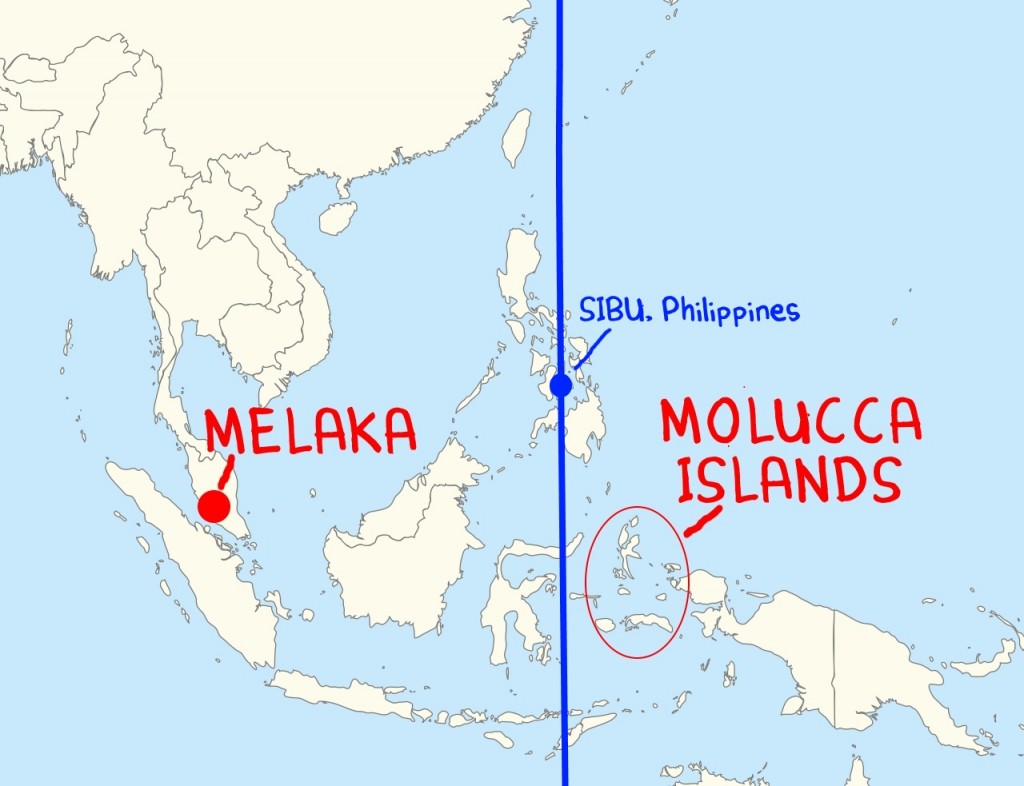
So if it’s true that Magellan and Enrique traveled to the Moluccas shortly after they met, and when you take that as the start point, then OMG BOTH ENRIQUE AND MAGELLAN WERE THE FIRST TO CIRCUMNAVIGATE THE WORLD!!!! Granted, this only works if you’re talking about simply circumnavigating the world from one longitude to another, not point to point.
And this is actually quite likely – remember Magellan’s cousin from earlier? After capturing Melaka, Albuqueque appointed Magellan’s cousin (Serrão) to lead the ships exploring the Moluccas, and it’s super plausible that Magellan would follow his cousin. The timeline also fits, as they would still have a year to participate in the Moroccan conflict. To add to this, Magellan’s expedition was named… The Armada de Moluccas as the whole goal of the voyage was to reach the Moluccas by sailing West. On an unrelated note, his cousin actually ended up getting killed around the same time as Magellan… DUNDUNDUN #conspiracy. So yeah, you can credit this one as a DarylTam/Cilisos theory k?
Thing is, all this is just speculation, based on circumstantial evidence. Pigafetta’s account, as the main primary source, is taken by conventional history as the definitive account of the first human circumnavigation led by Magellan and then Elcano. There’s also another guy called Maximillian who interviewed the surviving members of Elcano’s ship, but they mostly corroborate Pigafetta’s else we would have brought it up sooner. As such, we know that these four things are fact:
- Enrique exists.
- Enrique was captured in Melaka and spoke fluent Malay, Spanish and Portuguese.
- Enrique was close enough to Magellan to be included in Magellan’s will.
- Enrique did not die with the rest of the crew in the Philippines
The rest (including ours)… as they say, are just…

Also, for the full Straits Times article from 1955 in the title image, click here.
PS: If you’d like more stories like this, please subscribe to our HARI INI DALAM SEJARAH Facebook group 🙂
- 8.5KShares
- Facebook8.3K
- Twitter10
- LinkedIn20
- Email24
- WhatsApp123

